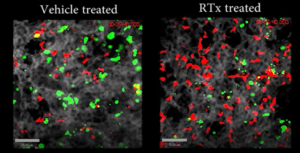Nociceptor sensory neurons suppress neutrophil and γδ T cell responses in bacterial lung infections and lethal pneumonia
4/4/2018
Pankaj Baral, Benjamin D Umans, Lu Li, Antonia Wallrapp, Meghna Bist, Talia Kirschbaum, Yibing Wei, Yan Zhou, Vijay K Kuchroo, Patrick R Burkett, Bryan G Yipp, Stephen D Liberles & Isaac M Chiu
This featured article emphasizes the role of the nervous system as a target for non-antibiotic therapies that boost lung immunity or promote healing.
Lung-innervating nociceptor sensory neurons detect noxious or harmful stimuli and consequently protect organisms by mediating coughing, pain and bronchoconstriction. Specifically, Baral et al. describes neurons that carry nerve signals to and from the lungs which suppress immune response during fatal lung infections with the bacterium Staphylococcus aureus.
Therefore, disabling these neurons could boost immune response and promote bacterial clearance to aid recovery. Animal experiments like Baral et. al. in Nature Medicine, that target neuro-immune signaling in the lungs toward nonantibiotic therapies for bacterial pneumonia, show promise.
Here, they found that TRPV1+ nociceptors suppressed protective immunity against lethal Staphylococcus aureus pneumonia. Targeted TRPV1+-neuron ablation increased survival, cytokine induction, and lung bacterial clearance. Nociceptors suppressed the recruitment and surveillance of neutrophils, and altered lung γδ T cell numbers, which are necessary for immunity. Vagal ganglia TRPV1+ afferents mediated immunosuppression through release of the neuropeptide calcitonin gene–related peptide (CGRP). Targeting neuroimmunological signaling may be an effective approach to treat lung infections and bacterial pneumonia
Read more in: Baral, Umans, Li, et al. Nociceptor sensory neurons suppress neutrophil and γδ T cell responses in bacterial lung infections and lethal pneumonia. Nature Medicine. 2018 (3).

 Immune & Epithelial Interactions
Immune & Epithelial Interactions Allergy & Asthma
Allergy & Asthma





